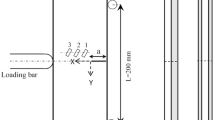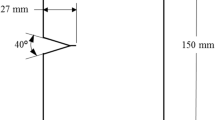Abstract
The dynamic fracture behavior of layered architectures is experimentally studied. Specifically, crack penetration, trapping, and branching at an interface are examined. A newly introduced optical technique called Digital Gradient Sensing (DGS) that quantifies elasto-optic effects due to a non-uniform state of stress is extended to perform full-field measurements during the fracture event using ultrahigh-speed photography. By exploiting the richness of two simultaneously measured orthogonal stress gradient fields, a modified approach for extracting stress intensity factors (SIFs) is implemented for propagating crack-tips under mixed-mode conditions. The method is first calibrated using a quasi-static experiment complemented by finite element simulations before implementing it for studying dynamic mixed-mode fracture mechanics of layered configurations. The layered systems considered consist of two PMMA sheets bonded using an acrylic adhesive with the interface oriented normally to the initial crack propagation direction. Interfaces are characterized as ‘strong’ and ‘weak’ by their crack initiation toughness. The dynamic fracture of monolithic PMMA sheet is also studied in the same configuration for comparison. The crack growth and fracture parameter histories of propagating cracks are evaluated. The interface is shown to drastically perturb crack growth behavior resulting in higher dissipation of fracture energy by exciting crack trapping, branching, and mixed-mode growth mechanisms.




















Similar content being viewed by others
Notes
The crack speeds in the interface vicinity show gyrations and hence using transient crack-tip field descriptions [28] involving derivatives of SIF values are more appropriate. However, in view of potential inaccuracies associated with numerical differentiation of SIF values, a steady-state approximation is adopted in this work.
Note that data for only one of the two cracks is shown in Fig. 17.
References
Patel PJ, Gilde GA, Dehmer PG, McCauley JW (2000) Transparent armor. AMPTIAC Newslett 4(3)
Subhash G (Guest Editor) (2013) Special issue on ‘Transparent Armor Materials’. Exp Mech 53(1):1–2
Wang J, Xu Y, Zhang W (2014) Finite element simulation of PMMA aircraft windshield against bird strike by using a rate and temperature dependent nonlinear viscoelastic constitutive model. Compos Struct 108:21–30
Raghuwanshi RK, Verma VK (2014) Mechanical and thermal characterization of aero grade polymethyl metha acrylate polymer used in aircraft canopy. Int J Eng Adv Tech (IJEAT) 3(5):216–219
Freund LB (1990) Dynamic fracture mechanics. Cambridge University Press, New York
Broberg KB (1999) Cracks and fracture. Academic, San Diego
Xu LR, Huang YY, Rosakis AJ (2003) Dynamic crack deflection and penetration at interfaces in homogeneous materials: experimental studies and model predictions. J Mech Phys Solids 51:461–486
Washabaugh PG, Knauss WG (1994) A reconciliation of dynamic crack growth velocity and Rayleigh wave speed in isotropic brittle solids. Int J Fract 65:97–114
Rosakis AJ, Samudrala O, Coker D (1999) Cracks faster than shear wave speed. Science 284:1337–1340
Hutchinson JW, Suo Z (1992) Advances in applied mechanics, vol. 29. Academic, New York, pp 63–191
Suresh S, Sugimura Y, Tschegg EK (1992) Growth and fatigue crack approaching a perpendicular-oriented bimaterial interface. Scr Metall Mater 27:1189–1194
Chalivendra VB, Rosakis AJ (2008) Interaction of dynamic mode-I cracks with inclined interfaces. Eng Fract Mech 75:2385–2397
Park H, Chen W (2011) Experimental investigation on dynamic crack propagating perpendicular through interface in glass. J Appl Mech 78(5),051013
Xu LR, Rosakis AJ (2003) An experimental study of impact-induced failure events in homogeneous layered materials using dynamic photoelasticity and high-speed photography. Opt Lasers Eng 40:263–288
Xu LR, Rosakis AJ (2005) Impact damage visualization of heterogeneous two-layer materials subjected to low-speed impact. Int J Damage Mech 14:215–233
Mason JJ, Lambros J, Rosakis AJ (1992) The use of a coherent gradient sensor in dynamic mixed-mode fracture mechanics experiments. J Mech Phys Solids 40(3):641–661
Tippur HV, Rosakis AJ (1991) Quasi-static and dynamic crack growth along bimaterial interfaces: A note on crack-tip field measurements using coherent gradient sensing. Exp Mech 31(3):243–251.
Tippur HV, Krishnaswamy S, Rosakis AJ (1992) Optical mapping of crack-tip deformations using the methods of transmission and reflection coherent gradient sensing: A study of crack-tip K-dominance. J Mech Phys Solids 40(2):339–372
Kirugulige MS, Tippur HV (2006) Mixed-mode dynamic crack growth in functionally graded glass-filled epoxy. Exp Mech 46(2):9–281
Singh RP, Lambros J, Shukla A, Rosakis AJ (1997) Investigation of the mechanics of intersonic crack propagation along a bimaterial interface using coherent gradient sensing and photoelasticity. Proc R Soc Lond A 453:2649–2667
Winkler S, Shockey DA, Curran DR (1970) Crack propagation at supersonic velocities I. Int J Fract Mech 6:151–158
Curran DR, Shockey DA, Winkler S (1970) Crack propagation at supersonic velocities II. Theoretical model. Int J Fract Mech 6:271–278
Periasamy C, Tippur HV (2012) A full-field digital gradient sensing method for evaluating stress gradients in transparent solids. Appl Opt 51(12):2088–2097
Periasamy C, Tippur HV (2013) Measurement of orthogonal stress gradients due to impact load on a transparent sheet using digital gradient sensing method. Exp Mech 53:97–111
Williams ML (1959) On the stress distribution at the base of a stationary crack. J Appl Mech 24:109–114
Periasamy C, Tippur HV (2013) Measurement of crack-tip and punch-tip transient deformations and stress intensity factors using digital gradient sensing technique. Eng Fract Mech 98:185–199
Xu LR, Rosakis AJ (2003) Real-time experimental investigation of dynamic crack branching using high-speed optical diagnostics. Exp Tech 23–26
Freund LB, Rosakis AJ (1992) The structure of the near-tip field during transient elastodynamic crack growth. J Mech Phys Solids 40:699–719
Chalivendra V, Shukla A (2005) Transient elastodynamic crack growth in functionally graded materials. J Appl Mech 71:237–248
Kitey R, Tippur HV (2008) Dynamic crack growth past stiff inclusion: Optical investigation of inclusion eccentricity and inclusion-matrix adhesion strength. Exp Mech 48(1):37–54
Maleski MJ, Kirugulige MS, Tippur HV (2004) A method for measuring mode i crack tip constraint under static and dynamic loading conditions. Exp Mech 44(5):522–532
Mello M, Hong S, Rosakis AJ (2009) Extension of the coherent gradient sensor (CGS) to the combined measurement of in-plane and out-of-plane displacement field gradients. Exp Mech Special edition 49:277–289
Acknowledgments
The support for this research by the U.S. Army Research Office through grant W911NF-12-1-0317 is gratefully acknowledged.
Author information
Authors and Affiliations
Corresponding author
Appendices
Appendix 1
Mixed-Mode FE Simulation
A complementary quasi-static finite element simulation of the mixed-mode tension experiment was carried out using ABAQUS® software. The model was discretized into 4589 four node bilinear plane stress quadrilateral elements. The local seeding around the crack-tip was used to generate a fine mesh in the crack-tip vicinity. Table 1 shows the material properties of PMMA used in the simulation. The discretized model and the boundary conditions used are shown in Fig. 21. Displacements corresponding to the cross-head speed during the experiment were imposed at one end of the specimen in a series of steps. A local coordinate system aligned with the crack direction was defined for post-processing the data. The crack opening (COD) and crack sliding (CSD) displacements were extracted along the two crack faces. This was repeated for each displacement step. The apparent mode-I and mode-II SIFs, (K I ) app and (K II ) app at each displacement step were computed using [26],
where E is the elastic modulus, (r, θ) are the crack-tip polar coordinates, u y ′ is the half COD and u x ′ is the half CSD of the crack flanks. By extrapolating the linear portion of (K I ) app and (K II ) app values plotted as a function of the radial distance r to the crack tip, the true K I and K II were determined.
Appendix 2
Experimental Repeatability
Multiple experiments were conducted for monolithic and bi-layered configurations (both weak and strong interface cases) to ensure repeatability in terms of dynamic fracture behavior as well as fracture parameters. Fig. 22(a) shows photographs of two fractured samples of monolithic specimen whereas Fig. 22(b) and (c) show two fractured samples of specimens with strong and weak interface, respectively. A high degree of reproducibility in crack paths throughout the fracture event (well past the interface) is clearly evident in Figs. 22(b) and (c). Figure 23(a) and (b) show SIF histories for two different samples with a weak and a strong interface, respectively. Again, repeatability can be readily seen in the measured values of SIF histories too. That is, the SIF histories of multiple samples closely agree with each other before the crack reaches the interface. After the crack penetrates the second layer there are only marginal differences between the two SIF histories. Despite the highly transient nature of the problem, and the possibility of potential variations in material and interface characteristics, a rather high degree of reproducibility is evident.
Rights and permissions
About this article
Cite this article
Sundaram, B., Tippur, H. Dynamic Crack Growth Normal to an Interface in Bi-Layered Materials: An Experimental Study Using Digital Gradient Sensing Technique. Exp Mech 56, 37–57 (2016). https://doi.org/10.1007/s11340-015-0029-x
Received:
Accepted:
Published:
Issue Date:
DOI: https://doi.org/10.1007/s11340-015-0029-x







